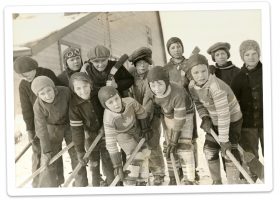By Marie Siemens – Nanaimo, B.C.
“Behind every successful seamstress lies a mountain of scraps,” so read a declaration sitting on the checkout counter of a fabric store I visited several years ago. Immediately I wished I could see how big my mountain was, so I could know whether I’d been successful or not!
My first introduction to a sewing machine occurred when I was three years old, not as a seamstress, but instructed by my big sister to dust mom’s Beaver treadle as part of Saturday morning housecleaning time. Our mom had not been well for over a year, so it fell to sis, being in charge of the household and taking care of me.
I suppose she figured this would keep me out of mischief for the time being anyway, and I didn’t mind dusting chairs in the least – that was easy!
The multiple curves in the wrought-iron stand of the machine was another thing. I found it frustrating because I could never be sure if I’d missed anything. I’d work away at it until I decided enough was enough and quit. Strangely enough, I never got checked up on and I was free for another week.
A few years passed and since I didn’t have any playmates, I was left mainly to my own devices of occupying my time. Upon occasion, I would pretend the sewing machine was a pump organ. Feet on treadle, fingers pressing pretend keys. When I tired of that, I pedalled as fast as I could just to see the wheels spin.
The day came when it struck me that all this was rather foolish. I can still see it all – sunshine coming through the window on a winter’s afternoon, with mom and myself the only ones at home at the time. Mom was working in the kitchen.
“Mom,” I said, “I’d like to learn how to sew.”
“Really?” she asked.
“Oh, yes. Could you show me?”
To my delight she left whatever she was doing and came over.
Lesson remembered years later
First, she briefly pointed out the functions of each working part. How to thread it. How to bobbin and insert it into the shuttle. Actually, that wouldn’t have been all that necessary as I’d watched her doing those things many times.
She brought out a piece of experienced fabric and tore it into squares. “Now join them one to another,” she said. A short time later she came back to see how I was doing.
“Why are you making your seams so crooked?” she asked. “There’s no need for them to look like this.”
“Look,” she said, pointing to the presser foot, “you always have your guide right here. Just keep the edges of your fabric lined up with it and your seams will be straight.”
I was seven at the time and recently celebrated my 90th milestone. Those words have stayed with me and I’m still sewing, mostly making quilts to give away. In between that first stitch and now, I kept a family clothed with everything they wore – except footwear, although I did make boot liners and slippers!
Without my ability to sew, our children would have looked like ragamuffins because we didn’t have any funds to purchase “ready-mades”.
Fabrics could be purchased by the pound – advertised in the farm papers – and factory mill ends from eastern Canada. Oftentimes, someone would come with a box of various stuff, saying, “I know you sew. I just wondered if you could make use of this.”



